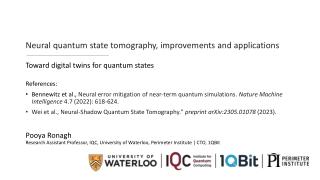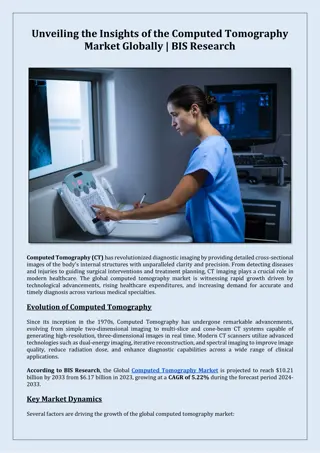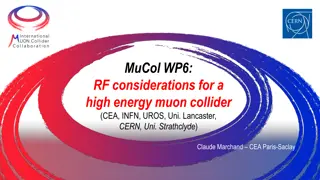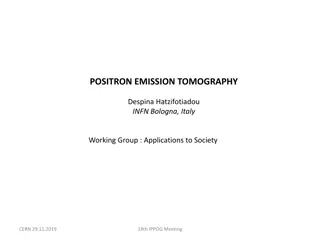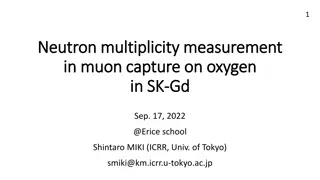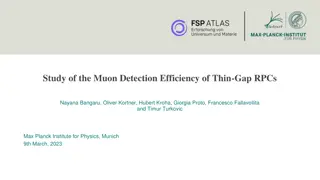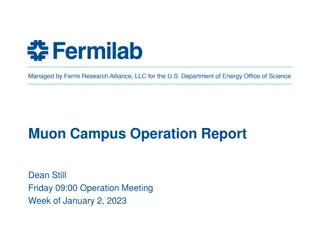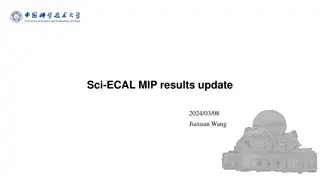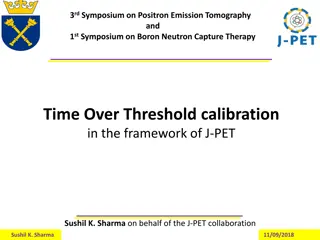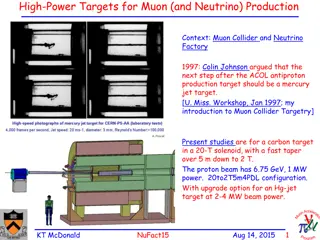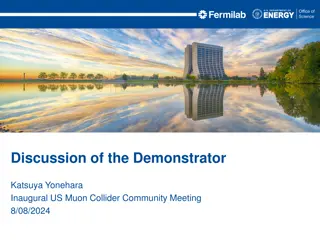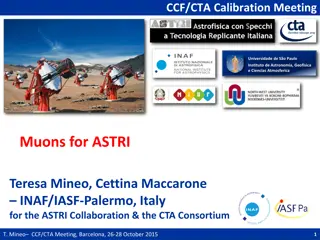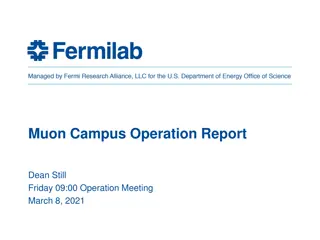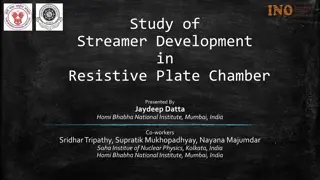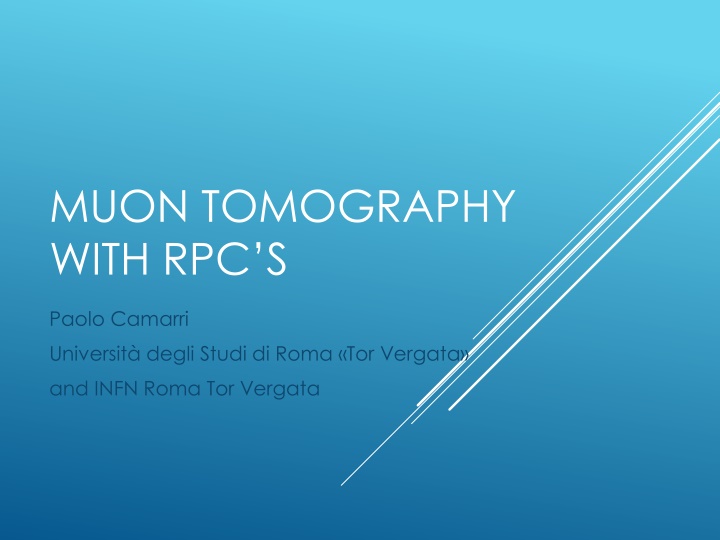
Muon Tomography with RPC: Features, Implications, and Design
Explore the world of Muon Tomography with Resistive Plate Chambers (RPCs) as discussed by Paolo Camarri from Universit degli Studi di Roma Tor Vergata and INFN Roma Tor Vergata. Discover the general features of RPCs, space resolution achievable, implications of atmospheric muon flux, and the design considerations for a muon tomograph for scanning containers at harbors. Learn about the capabilities and applications of RPCs in experiments such as ATLAS at CERN, ARGO in Tibet, and OPERA at LNGS, highlighting the importance of RPC devices in achieving high space resolution. Understand the atmospheric muon flux at sea level and its impact on obtaining surface resolution. Explore the mandatory device requirements for scanning containers at harbors efficiently.
Download Presentation

Please find below an Image/Link to download the presentation.
The content on the website is provided AS IS for your information and personal use only. It may not be sold, licensed, or shared on other websites without obtaining consent from the author. If you encounter any issues during the download, it is possible that the publisher has removed the file from their server.
You are allowed to download the files provided on this website for personal or commercial use, subject to the condition that they are used lawfully. All files are the property of their respective owners.
The content on the website is provided AS IS for your information and personal use only. It may not be sold, licensed, or shared on other websites without obtaining consent from the author.
E N D
Presentation Transcript
MUON TOMOGRAPHY WITH RPC S Paolo Camarri Universit degli Studi di Roma Tor Vergata and INFN Roma Tor Vergata
General features of Resistive Plate Chambers Space resolution achievable with RPCs Implications of atmospheric-muon flux for muon tomography Design of a muon tomograph for scanning containers at harbours Possible improvements due to RPC read-out geometry OUTLOOK
The Resistive Plate Chamber is a gaseous detector with resistive electrodes and planar geometry It was designed at the beginning of the 80 s by R. Santonico and R. Cardarelli Basic idea: a detector with time resolution comparable to traditional scintillators coupled to PMTs ( 1 ns or so), and cheap enough so that large detection areas (up to the order of 104m2and more) can be instrumented at reasonable cost A GLIMPSE ON RESISTIVE PLATE CHAMBERS
Covered area: about 7000 m2 RPC S IN THE ATLAS EXPERIMENT AT CERN
Covered area: about 6700 m2 RPC S IN THE ARGO EXPERIMENT IN TIBET
Covered area: about 6000 m2 RPC S IN THE OPERA EXPERIMENT AT LNGS
With small-size RPC devices (with 8 10 mm pitch read-out strips), 100 m space resolution was obtained Therefore, with larger-size RPC devices, 300 500 m space resolution can be achieved This results in a 0.15 0.2 mrad angular resolution for the scattering angle over a 2.5 m distance SPACE RESOLUTION WITH RPC S
The flux of atmospheric muons at sea level is of the order of 1 cm-2min-1 This constraints the minimum time required to obtain a given surface resolution E.g., if we require at least 10 hits on a given area, in 1 min a resolution about 10 cm2can be obtained ATMOSPHERIC-MUON FLUX AND MUON TOMOGRAPHY
Mandatory device requirement: capability of scanning ALL the containers arriving at the harbour. E.g. for about 1500 containers/day the available time per container would be about 1 min (and consequently modest resolution) With a suitably sized detector, more containers can be scanned at the same time, with consistent advantage for the area resolution that can be obtained. We can imagine a pipeline of N containers scanned in parallel between the ship and the truck Therefore, the scanning device should cover a suitable space between the ship dock and the truck-charging area E.g., in order to obtain 1 cm2resolution, 10 mins scanning time would be necessary: this constaints the minimum number of containers to be scanned at the same time (for 1440 containers/day arriving at the harbour, at least 10 containers should be scanned in parallel) SCANNING OF CONTAINERS AT HARBOURS WITH MUON TOMOGRAPHY
By suitable orientation of the RPC read-out panels in different layers of the detector, independent tracking on two orthogonal views can be performed This results in an improved space resolution of a factor 2 IMPROVING SPACE RESOLUTION
A team of enterprises has won a regional call in Lazio to build and test a muon-tomography demonstrator for the Civitavecchia harbour The test set-up is structured in three overlapped containers: the middle one is the container to be scanned, and the uppermost and lowermost ones are used to host the detector stations for the incoming and outgoing muon tracks The chamber layout is similar to the one presently used for the CMS muon-trigger RPC s: i.e. a read-out strip plane sandwiched between two gas gaps Two overlapped chambers with orthogonal read-out strips provide a point in space Both in the uppermost and in the lowermost container, two chamber doublets provide a track segment respectively for the incoming and outgoing muons. MUON-SCATTERING TOMOGRAPHY AT THE CIVITAVECCHIA HARBOUR
This idea was initially exploited by L. Alvarez for scanning Chefren s pyramid in search for possible hidden chambers in the 60 s Very recently, a successful scanning of Cheops pyramid was performed, hinting at the existence of hidden cavities in its structure So, this approach is still extremely relevant for certain applications involving extremely massive structures that can be crossed only by very energetic muons -> very modest muon flux So, in order to collect significant statistics within a reasonable time, a very large area detector is required. An RPC-based device would be an excellent candidate. MUON-ABSORPTION TOMOGRAPHY

